
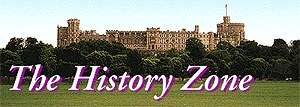
A Brief History
of Windsor
Updated February
2007
See also
The History
Zone Index
The Royal Windsor
Forum Royal
Windsor Home Page
Prehistoric Times
There are signs that the Thames Valley
has been inhabited from the very earliest times. Paleolithic
Man has lived here since the ice ages, hunting on the river banks.
Examples of his weapons have been found during recent excavations
and where gravel extraction has taken place. Areas of gravel
extraction are primarily upstream of Maidenhead and on the northern
areas of the valley, in Buckinghamshire. Animal remains that
have been discovered over the years include mammoth, rhinoceros,
aurochs, (a horned cow-like creature), as well as deer and horses.
Remains have been found during excavation work for the Cavalry
Barracks in St Leonards Road in 1867, later to be known as Combermere
Barracks, and in Peascod Street in 1958, in Park Street in 1962
and on the site of the original swimming pool at Clewer in the
early 1960s.
Following the Ice Age forests began to grow and human
habitation continued with examples of flint 'picks' and bone
'axe-hammers' found in the river. A small collection of palstaves
(axes) were found near Bishopsgate in Windsor Great Park in the
1860s, which are believed to be Bronze Age, plus the remains
of a dug-out canoe was found in Windsor in 1871, a model of which
has been made for display in the, now sadly closed, Windsor Museum.
Other artifacts, such as a very fine brooch decorated with an
amber and glass beads and dating from about 400BC have been found
in the area.
Roman and Saxon Times
The area surrounding Windsor was not a
major Roman centre during the Roman occupation although there
are examples of pottery, some coins, tiles and two tile-tombs
from an excavation in the 1950s at Kingsbury, Old Windsor. There
are the remains of a Roman camp on St Leonards Hill where the
base of an urn was found.
By Saxon times a Royal Manor had been established
at Old Windsor where Great Councils of the Realm were held in
the days of Edward the Confessor and William I and II. Excavations
between 1951 and 1958 revealed a number of wooden buildings and
rubbish pits. The site of a water-mill and its canal was also
discovered, the first of this period to be discovered in the
UK. These discoveries show that Old Windsor was inhabited from
around 700AD and one of the oldest towns in Berkshire at the
time.
The Castle
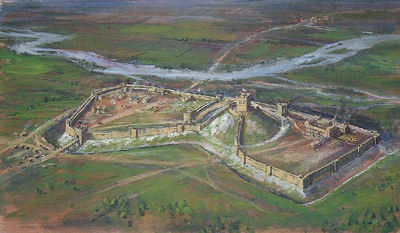
The artist's impression above illustrates
how the castle might have looked in its earliest days, constructed
on a chalk mound on a bend of the river amidst a barely populated
landscape. No claims of historical accuracy are made for this
painting (by Michael Vicary).
Windsor (or to be strictly accurate 'New Windsor') first
came into being around 1070 when William the Conqueror established
a fortification on a chalk mound on a bend in the river, two
miles from his palace at Kingsbury, Old Windsor.
Before this time the area where
Windsor now sits would have been just another hill, possibly
downland as it was primarily chalk, on a bend in the river, with
perhaps a few simple buildings. There is evidence of a hamlet
to the eastern side, known as Orton.
Prior to the Norman Conquest,
Edward the Confessor had held court at the Royal Manor at Kingsbury,
in what we now know as Old Windsor, until his death in January
1066. Shortly before his death he had transferred ownership of
the Manor of [Old] Windsor to the new Westminster Abbey, but
later that year, following the Norman Conquest, William the Conqueror
issued a charter reading "By the favour of the Abbot of
Westminster, I have agreed that Windlesora shall be for the King's
use."
The proximity to the River Thames
was no doubt the prime reason for choosing the area, the waterway
being the main highway to London to the east. In addition, the
extensive Windsor Forest offered excellent hunting and William
chose to live there until his death in 1087.
The name of Windsor derives from
Windlesore, or 'Winding Shores' where boats were pulled
by windlass ('windles') up the river. As with all such names
that date back many centuries, there are other claims as to the
derivation of the name. It has also been thought that the name
derived from 'winding' meaning 'meandering' shores. A third school
of thought stemmed from the belief that the name derived from
'a sore wind' referring to the wind that blew across the mound
upon which the Castle was built but this fails on chronological
grounds.
So a Royal connection with this
area has existed for more than 1000 years, even before the Norman
Conquest of 1066 and the subsequent construction of the first
fortifications that subsequently became the Castle as we know
it today. Initially the fortifications would have been merely
ditches and wooden palisades around Clewer Hill as the original
site of the castle was known. Indeed, the tower known today as
The Curfew Tower, was originally known as The Clewer Tower. The
area of Clewer dates back to Roman times also, the Latin name
being Clivore. The present Parish of Clewer is divided into two
parts, Clewer Within, i.e. the town of Windsor, and Clewer Without,
the area to the west of the town.
After the Norman Conquest, William
I built a ring of fortresses within one day's march of London,
of which Windsor is undoubtedly the finest. The site was chosen
for its height, some 100 feet above the river, and its proximity
to other castles that William had constructed to the west of
London, at Berkhamstead and Guildford. Other castles were built
in Ongar, Hertford and Pleshy to the north, Rayleigh and Rochester
to the east and Tonbridge and Reigate to the south. The concept
of castles was unknown to the Saxons and was part of William's
plan to ensure the permanence of the conquest.
The Castle has been a royal residence
since 1110 when Henry I began using it, transferring from the
earlier court in Old Windsor. In 1121 Henry married in the Castle
Chapel, his Queen being consecrated and crowned there. With the
coming of the court, the castle developed further, and the original
wooden structures were replaced by stone in the period from 1173
to 1179, together with the characteristic rectangular towers.
Windsor Castle has only rarely
seen any action. There had been a siege in 1193 when, whilst
he was on Crusade, Richard Coeur de Lion's brother, John, attempted
to seize the crown. The Church Judiciary of the day, headed by
the Archbishop of Rouen, elected not to oppose this usurper,
but others decided that John should be ousted and he was besieged
for almost two months after which John surrendered.
Twenty three years later, when
John was legitimately king, he was forced to accede to the demands
of the Barons by the sealing of Magna Carta, at Runnymede, in
1215. Yet this was not implemented to the Barons satisfaction
so, just one year later, in May 1216, French forces landed to
help the Barons in their dispute with King John. A siege at Dover
Castle took place in June, and a few days later the Barons arrived
at Windsor. John was not in residence, he was at Corfe Castle
on the south coast, leaving the defence of Windsor to Engelhard
de Cygony, the Constable of the Castle. The attacks lasted for
nearly three months when the besieging forces chased John's army
into East Anglia. John died during that pursuit, they say from
'a surfeit of peaches and beer.'
Tighe and Davis, in their history
'Annals of Windsor' (1858) describe the siege of Windsor as follows:
"They were long there, but did little, and were
in great jeopardy. The besieged made many fierce sallies, twice
cutting the beam of their perriere (the name given to the engine
for throwing large stones, the greater part of which consisted
of a long beam). A knight of Artois, called William de Ceris,
was killed, lamented by few, for he was hated much."
In the meantime, the king, finding his enemies occupied
with the sieges of the two castles of Windsor and Dover, availed
himself of the opportunity to pillage and lay waste the estates
of the barons. He was at Reading on the 7th of September, and
came so near Windsor that the besiegers expected a battle. The
Welshmen, approaching by night, shot at them with their arrows.
The besiegers remained armed a long time, prepared for the fight,
but none occurred, the king withdrawing.
After remaining a week at Sonning, he proceeded to
Wallingford and Cambridge. The barons, hearing of the king's
movements, and not making any progress at Windsor, determined,
under the advice of the Count de Nevers, to raise the siege,
and cut off the king's retreat. They left their tents at night,
and marched with all haste towards Cambridge. The king, being
apprized of their movements, moved to Stamford and Lincoln.
It was rumoured that the Count de Nevers had been
bribed by presents from John to raise the siege of Windsor. Be
that as it may, the barons did not return to the siege, but finding
the king had escaped them, returned to London, and then joined
Louis at Dover.
Windsor consequently remained in the hands of the
king's friends.
By 1217 the castle and surrounding dwellings
must have been in a sad state of repair following the ravages
of the besieging armies, their siege engines, their raids for
food, and the inevitable fires. The residents of the town would
almost certainly have taken shelter within the castle, helping
to defend it, and providing a source of food to some extent,
from their live stock such as pigs and sheep. However, it was
not until the year 1230, some thirteen years later, that Henry's
grandson, Henry III built a 'curtain wall' and three drum towers
to the west beyond the line of the original Norman fortifications.
Henry also built royal apartments in the Upper and Lower Wards,
now occupied by the State Apartments and Canon's Cloisters respectively.
It was at this time that Henry built a Chapel dedicated to Edward
the Confessor, later to become St George's Chapel in 1348. The
present St George's Chapel was started in 1475 by Edward IV as
he wished Windsor to be the centre of his dynasty, with royal
burials taking place there. The chapel was not completed for
over 50 years until the reign of Henry VIII, in 1528.
With these building works by Henry
III, the Castle was now a substantial and influential royal residence,
one of the finest in Europe, and by their very imposing existence,
effective in keeping law and order. Windsor too would have prospered
in the ensuing peace. Windsor maintained its position as the
prime Royal Residence and in 1239 the Queen, Eleanor of Provence,
gave birth to her first child, the future Edward I. The Castle
saw more building and extension work to provide Edward, now with
a younger sister, Margaret (b. September 1240), a courtyard in
which to play. The community of the Castle would have been quite
substantial, with courtiers and their families, and the many
workers that a large royal residence would have required.
Windsor was not always thereafter
the residence of choice. Edward himself, when he became King
Edward I, apparently stayed at Windsor only on a few occasions
each year. But these were major occasions, tournaments in the
Park, military exercises, feasts and jousts.
The military tournaments at Windsor
gave rise to The Most Noble Order of the Garter in 1348, during
the reign of Edward III, which was celebrated by feasting and
jousting. Knights of the Garter are also known as Military Knights
to this day. For over 600 years new Knights of the Garter have
been invested annually at The Garter Service, which takes place in
St George's Chapel in mid June. St George's Chapel itself was
started in 1475 by Edward IV with the final stone vaulted ceiling
completed by his son-in-law, Henry VII, by 1528. The Chapel is
one of the finest examples of Perpandicular Gothic, the late
medieval style. Ten sovereigns are buried at St George's.
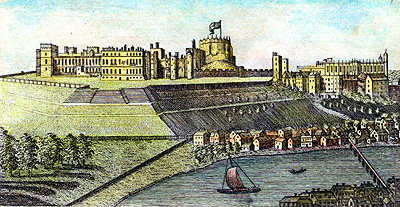
An early illustration of Windsor
Castle, showing the wooden bridge to Eton, St George's Chapel,
top right, and the State Apartments to the left.
The Town
As the castle grew, so did the town. Edward I made Windsor a Free Borough
and granted the town its first Charter in 1276 at which time
New Windsor was the county town of Berkshire. In 1314 however,
as Windsor's location at the far eastern end of the county was
considered too inconvenient, the distinction was transferred
to Reading.
From the days of Edward I, until the Parliamentary
Representation Act of 1918,Windsor was a Parliamentary Borough.
Its right to send two representatives to the House of Commons
was exercised (with the exception of a considerable period between
the reigns of Edward II and Henry IV) until the Reform Act of
1867 deprived it of one of its members. In order to retain a
sufficiently large population to justify this one remaining member,
other parts of Clewer, as well as Eton were added into the Parliamentary
Constituency. With the new Act of 1918, Windsor no longer had
its own MP. By the end of the nineteenth century, the constituency
now included Maidenhead also.
The town around the Castle
has remained small for a number of centuries, development of
land to the east and south being prevented by the surrounding
Crown land that comprises the Home Park and Windsor Great Park. Also, Eton College land
to the north was similarly unavailable for expansion and land
alongside the river, regularly flooded, would not have been appropriate
for the construction of homes or factories. In the late 1840s
there was a major reorganisation of the lands around the castle
to the east, where previously enclosed areas were opened up to
become The Home Park, while to the south of the new Datchet Road
and Victoria Bridge, public access was no longer possible.
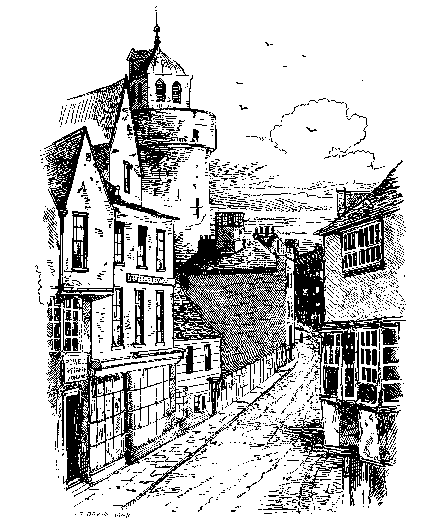
The buildings to the left were
removed in the late 1840s and the Bell Tower altered to the 'Pepper
Pot' design we know today.
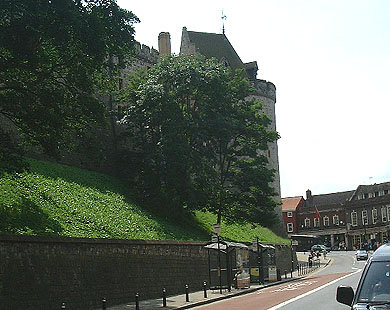
The Curfew Tower (Bell Tower) in
2000
The town began to change faster in Victorian
times when a significant number of terraced houses were constructed
in areas to the south and around to the west of Windsor. Semi-detached
homes, described as 'villas' in Victorian times, were also built
together with some more substantial homes for the 'well to do'.
This significant growth in housing is probably due to the arrival
of the railways in Windsor in 1849 which permitted convenient
access to London. In the early 1900s slum dwellings in Bier
Lane (now River Street) were removed at the same time as
Barry Avenue and the river promenade
was created. Further slums were removed in the late 1920s to
create the River Street Car Park.
The Goswells, at the foot of the castle to the west were
created after a slum clearance scheme using a fund set up in
1910 to purchase the land and thereby protect the view of the
castle from the west. This area is now in the care of the National
Trust. In 1902-3 Alexandra
Gardens were created beyond The Goswells, now an attractive
open area adjacent to the river promenade at Barry Avenue.

The Goswells and Curfew Tower by
A R Quinton in the early 1900s
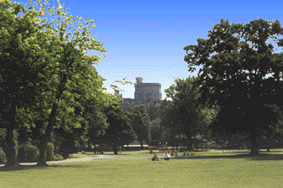
Alexandra Gardens, looking east
towards The Goswells and the Castle
In recent years new estates have been built
to the west, initially after World War Two, and later in the
1960s and 1970s. At the same time, some of the original terraces
closer to the town centre were lost in the 1960s when the unattractive
Ward Royal was built.
Windsor Bridge
A bridge to Eton has existed since 1268
or before, but being wooden, fell often into disrepair. The present
bridge, an early cast iron and stone structure, was completed
in 1824. After over 140 years, when horse and carts had for many
years been superseded by cars, lorries and double decker buses,
the bridge was finally deemed unsafe, and was closed to all vehicular
traffic. Our Windsor History section features two articles about
Windsor Bridge
and the Bridges Downstream
of Windsor.
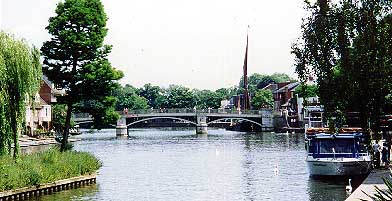
Windsor Bridge, looking east, downstream
Windsor's Two Train Stations
As a Royal Town, Windsor attracted the
attentions of both the Windsor, Staines and Richmond Railway
Company, (subsequently the Southern Railway Company), and Brunel's
Great Western Railway, each vying with the other for Queen Victoria's
patronage, and both providing a Waiting Room at their respective
stations, though if either believed that Her Majesty would be
prepared to wait for one minute, they were mistaken!
The Royal Waiting Rooms still
exist, one in the Central Station (serving the Great Western
main line at Slough on the Paddington, London to Bristol line),
and one in Datchet Road adjacent to the Southern Region, Windsor
and Eton Riverside, which connects with Waterloo Station in London.
The railways arrived within months
of each other in 1849. Brunel's line from Slough being on raised
arches across the river, rising up to the town centre, while
the Southern Railway approached from the east, through Crown
land, the station as we know it today being completed in 1851.
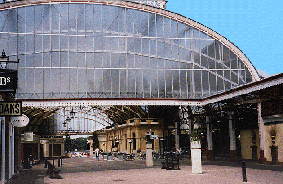
Queen Victoria's Waiting Room (centre) under the roof of the
Central Station, the Great Western Railway terminal from Slough
and Paddington.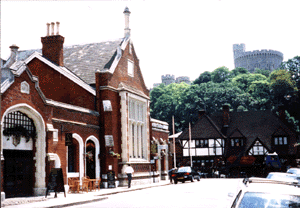
The Southern Railway station at
Windsor Riverside, connecting with Waterloo Station in London
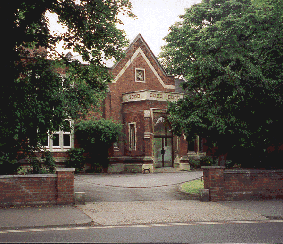
The Royal Waiting Room to the south
side of Windsor Riverside Station
The arrival of the railways made Windsor
far more accessible from London and elsewhere, and so began the
increase in tourism and day-tripping to the town and to the open
areas of The Brocas (below, to the left) where many a fine picnic
would be enjoyed, with views of Windsor and the Castle across
the Thames, along with opportunities for boating and swimming.
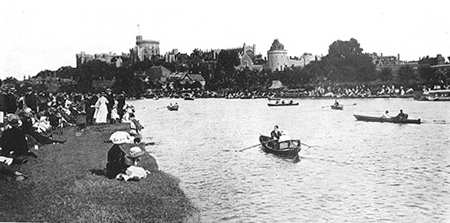
Rowing skiffs were the order of the day
in the early 1900s plus the odd steam launch.
See also
The History
Zone Index
The Royal Windsor
Forum Royal
Windsor Home Page

To contact us, email
Thamesweb.
 
of Windsor |
Prehistoric Times
There are signs that the Thames Valley
has been inhabited from the very earliest times. Paleolithic
Man has lived here since the ice ages, hunting on the river banks.
Examples of his weapons have been found during recent excavations
and where gravel extraction has taken place. Areas of gravel
extraction are primarily upstream of Maidenhead and on the northern
areas of the valley, in Buckinghamshire. Animal remains that
have been discovered over the years include mammoth, rhinoceros,
aurochs, (a horned cow-like creature), as well as deer and horses.
Remains have been found during excavation work for the Cavalry
Barracks in St Leonards Road in 1867, later to be known as Combermere
Barracks, and in Peascod Street in 1958, in Park Street in 1962
and on the site of the original swimming pool at Clewer in the
early 1960s.
Following the Ice Age forests began to grow and human
habitation continued with examples of flint 'picks' and bone
'axe-hammers' found in the river. A small collection of palstaves
(axes) were found near Bishopsgate in Windsor Great Park in the
1860s, which are believed to be Bronze Age, plus the remains
of a dug-out canoe was found in Windsor in 1871, a model of which
has been made for display in the, now sadly closed, Windsor Museum.
Other artifacts, such as a very fine brooch decorated with an
amber and glass beads and dating from about 400BC have been found
in the area.
Roman and Saxon Times
The area surrounding Windsor was not a
major Roman centre during the Roman occupation although there
are examples of pottery, some coins, tiles and two tile-tombs
from an excavation in the 1950s at Kingsbury, Old Windsor. There
are the remains of a Roman camp on St Leonards Hill where the
base of an urn was found.
By Saxon times a Royal Manor had been established
at Old Windsor where Great Councils of the Realm were held in
the days of Edward the Confessor and William I and II. Excavations
between 1951 and 1958 revealed a number of wooden buildings and
rubbish pits. The site of a water-mill and its canal was also
discovered, the first of this period to be discovered in the
UK. These discoveries show that Old Windsor was inhabited from
around 700AD and one of the oldest towns in Berkshire at the
time.
The Castle

Windsor (or to be strictly accurate 'New Windsor') first
came into being around 1070 when William the Conqueror established
a fortification on a chalk mound on a bend in the river, two
miles from his palace at Kingsbury, Old Windsor.
Before this time the area where
Windsor now sits would have been just another hill, possibly
downland as it was primarily chalk, on a bend in the river, with
perhaps a few simple buildings. There is evidence of a hamlet
to the eastern side, known as Orton.
Prior to the Norman Conquest,
Edward the Confessor had held court at the Royal Manor at Kingsbury,
in what we now know as Old Windsor, until his death in January
1066. Shortly before his death he had transferred ownership of
the Manor of [Old] Windsor to the new Westminster Abbey, but
later that year, following the Norman Conquest, William the Conqueror
issued a charter reading "By the favour of the Abbot of
Westminster, I have agreed that Windlesora shall be for the King's
use."
The proximity to the River Thames
was no doubt the prime reason for choosing the area, the waterway
being the main highway to London to the east. In addition, the
extensive Windsor Forest offered excellent hunting and William
chose to live there until his death in 1087.
The name of Windsor derives from
Windlesore, or 'Winding Shores' where boats were pulled
by windlass ('windles') up the river. As with all such names
that date back many centuries, there are other claims as to the
derivation of the name. It has also been thought that the name
derived from 'winding' meaning 'meandering' shores. A third school
of thought stemmed from the belief that the name derived from
'a sore wind' referring to the wind that blew across the mound
upon which the Castle was built but this fails on chronological
grounds.
So a Royal connection with this
area has existed for more than 1000 years, even before the Norman
Conquest of 1066 and the subsequent construction of the first
fortifications that subsequently became the Castle as we know
it today. Initially the fortifications would have been merely
ditches and wooden palisades around Clewer Hill as the original
site of the castle was known. Indeed, the tower known today as
The Curfew Tower, was originally known as The Clewer Tower. The
area of Clewer dates back to Roman times also, the Latin name
being Clivore. The present Parish of Clewer is divided into two
parts, Clewer Within, i.e. the town of Windsor, and Clewer Without,
the area to the west of the town.
After the Norman Conquest, William
I built a ring of fortresses within one day's march of London,
of which Windsor is undoubtedly the finest. The site was chosen
for its height, some 100 feet above the river, and its proximity
to other castles that William had constructed to the west of
London, at Berkhamstead and Guildford. Other castles were built
in Ongar, Hertford and Pleshy to the north, Rayleigh and Rochester
to the east and Tonbridge and Reigate to the south. The concept
of castles was unknown to the Saxons and was part of William's
plan to ensure the permanence of the conquest.
The Castle has been a royal residence
since 1110 when Henry I began using it, transferring from the
earlier court in Old Windsor. In 1121 Henry married in the Castle
Chapel, his Queen being consecrated and crowned there. With the
coming of the court, the castle developed further, and the original
wooden structures were replaced by stone in the period from 1173
to 1179, together with the characteristic rectangular towers.
Windsor Castle has only rarely
seen any action. There had been a siege in 1193 when, whilst
he was on Crusade, Richard Coeur de Lion's brother, John, attempted
to seize the crown. The Church Judiciary of the day, headed by
the Archbishop of Rouen, elected not to oppose this usurper,
but others decided that John should be ousted and he was besieged
for almost two months after which John surrendered.
Twenty three years later, when
John was legitimately king, he was forced to accede to the demands
of the Barons by the sealing of Magna Carta, at Runnymede, in
1215. Yet this was not implemented to the Barons satisfaction
so, just one year later, in May 1216, French forces landed to
help the Barons in their dispute with King John. A siege at Dover
Castle took place in June, and a few days later the Barons arrived
at Windsor. John was not in residence, he was at Corfe Castle
on the south coast, leaving the defence of Windsor to Engelhard
de Cygony, the Constable of the Castle. The attacks lasted for
nearly three months when the besieging forces chased John's army
into East Anglia. John died during that pursuit, they say from
'a surfeit of peaches and beer.'
Tighe and Davis, in their history
'Annals of Windsor' (1858) describe the siege of Windsor as follows:
"They were long there, but did little, and were in great jeopardy. The besieged made many fierce sallies, twice cutting the beam of their perriere (the name given to the engine for throwing large stones, the greater part of which consisted of a long beam). A knight of Artois, called William de Ceris, was killed, lamented by few, for he was hated much." In the meantime, the king, finding his enemies occupied with the sieges of the two castles of Windsor and Dover, availed himself of the opportunity to pillage and lay waste the estates of the barons. He was at Reading on the 7th of September, and came so near Windsor that the besiegers expected a battle. The Welshmen, approaching by night, shot at them with their arrows. The besiegers remained armed a long time, prepared for the fight, but none occurred, the king withdrawing. After remaining a week at Sonning, he proceeded to Wallingford and Cambridge. The barons, hearing of the king's movements, and not making any progress at Windsor, determined, under the advice of the Count de Nevers, to raise the siege, and cut off the king's retreat. They left their tents at night, and marched with all haste towards Cambridge. The king, being apprized of their movements, moved to Stamford and Lincoln. It was rumoured that the Count de Nevers had been bribed by presents from John to raise the siege of Windsor. Be that as it may, the barons did not return to the siege, but finding the king had escaped them, returned to London, and then joined Louis at Dover. Windsor consequently remained in the hands of the king's friends. |
By 1217 the castle and surrounding dwellings
must have been in a sad state of repair following the ravages
of the besieging armies, their siege engines, their raids for
food, and the inevitable fires. The residents of the town would
almost certainly have taken shelter within the castle, helping
to defend it, and providing a source of food to some extent,
from their live stock such as pigs and sheep. However, it was
not until the year 1230, some thirteen years later, that Henry's
grandson, Henry III built a 'curtain wall' and three drum towers
to the west beyond the line of the original Norman fortifications.
Henry also built royal apartments in the Upper and Lower Wards,
now occupied by the State Apartments and Canon's Cloisters respectively.
It was at this time that Henry built a Chapel dedicated to Edward
the Confessor, later to become St George's Chapel in 1348. The
present St George's Chapel was started in 1475 by Edward IV as
he wished Windsor to be the centre of his dynasty, with royal
burials taking place there. The chapel was not completed for
over 50 years until the reign of Henry VIII, in 1528.
With these building works by Henry
III, the Castle was now a substantial and influential royal residence,
one of the finest in Europe, and by their very imposing existence,
effective in keeping law and order. Windsor too would have prospered
in the ensuing peace. Windsor maintained its position as the
prime Royal Residence and in 1239 the Queen, Eleanor of Provence,
gave birth to her first child, the future Edward I. The Castle
saw more building and extension work to provide Edward, now with
a younger sister, Margaret (b. September 1240), a courtyard in
which to play. The community of the Castle would have been quite
substantial, with courtiers and their families, and the many
workers that a large royal residence would have required.
Windsor was not always thereafter
the residence of choice. Edward himself, when he became King
Edward I, apparently stayed at Windsor only on a few occasions
each year. But these were major occasions, tournaments in the
Park, military exercises, feasts and jousts.
The military tournaments at Windsor
gave rise to The Most Noble Order of the Garter in 1348, during
the reign of Edward III, which was celebrated by feasting and
jousting. Knights of the Garter are also known as Military Knights
to this day. For over 600 years new Knights of the Garter have
been invested annually at The Garter Service, which takes place in
St George's Chapel in mid June. St George's Chapel itself was
started in 1475 by Edward IV with the final stone vaulted ceiling
completed by his son-in-law, Henry VII, by 1528. The Chapel is
one of the finest examples of Perpandicular Gothic, the late
medieval style. Ten sovereigns are buried at St George's.

An early illustration of Windsor Castle, showing the wooden bridge to Eton, St George's Chapel, top right, and the State Apartments to the left.
The Town
As the castle grew, so did the town. Edward I made Windsor a Free Borough
and granted the town its first Charter in 1276 at which time
New Windsor was the county town of Berkshire. In 1314 however,
as Windsor's location at the far eastern end of the county was
considered too inconvenient, the distinction was transferred
to Reading.
From the days of Edward I, until the Parliamentary
Representation Act of 1918,Windsor was a Parliamentary Borough.
Its right to send two representatives to the House of Commons
was exercised (with the exception of a considerable period between
the reigns of Edward II and Henry IV) until the Reform Act of
1867 deprived it of one of its members. In order to retain a
sufficiently large population to justify this one remaining member,
other parts of Clewer, as well as Eton were added into the Parliamentary
Constituency. With the new Act of 1918, Windsor no longer had
its own MP. By the end of the nineteenth century, the constituency
now included Maidenhead also.
The town around the Castle
has remained small for a number of centuries, development of
land to the east and south being prevented by the surrounding
Crown land that comprises the Home Park and Windsor Great Park. Also, Eton College land
to the north was similarly unavailable for expansion and land
alongside the river, regularly flooded, would not have been appropriate
for the construction of homes or factories. In the late 1840s
there was a major reorganisation of the lands around the castle
to the east, where previously enclosed areas were opened up to
become The Home Park, while to the south of the new Datchet Road
and Victoria Bridge, public access was no longer possible.

The buildings to the left were removed in the late 1840s and the Bell Tower altered to the 'Pepper Pot' design we know today.

The town began to change faster in Victorian
times when a significant number of terraced houses were constructed
in areas to the south and around to the west of Windsor. Semi-detached
homes, described as 'villas' in Victorian times, were also built
together with some more substantial homes for the 'well to do'.
This significant growth in housing is probably due to the arrival
of the railways in Windsor in 1849 which permitted convenient
access to London. In the early 1900s slum dwellings in Bier
Lane (now River Street) were removed at the same time as
Barry Avenue and the river promenade
was created. Further slums were removed in the late 1920s to
create the River Street Car Park.
The Goswells, at the foot of the castle to the west were
created after a slum clearance scheme using a fund set up in
1910 to purchase the land and thereby protect the view of the
castle from the west. This area is now in the care of the National
Trust. In 1902-3 Alexandra
Gardens were created beyond The Goswells, now an attractive
open area adjacent to the river promenade at Barry Avenue.


Alexandra Gardens, looking east towards The Goswells and the Castle
In recent years new estates have been built to the west, initially after World War Two, and later in the 1960s and 1970s. At the same time, some of the original terraces closer to the town centre were lost in the 1960s when the unattractive Ward Royal was built.
Windsor Bridge
A bridge to Eton has existed since 1268 or before, but being wooden, fell often into disrepair. The present bridge, an early cast iron and stone structure, was completed in 1824. After over 140 years, when horse and carts had for many years been superseded by cars, lorries and double decker buses, the bridge was finally deemed unsafe, and was closed to all vehicular traffic. Our Windsor History section features two articles about Windsor Bridge and the Bridges Downstream of Windsor.

Windsor's Two Train Stations
As a Royal Town, Windsor attracted the
attentions of both the Windsor, Staines and Richmond Railway
Company, (subsequently the Southern Railway Company), and Brunel's
Great Western Railway, each vying with the other for Queen Victoria's
patronage, and both providing a Waiting Room at their respective
stations, though if either believed that Her Majesty would be
prepared to wait for one minute, they were mistaken!
The Royal Waiting Rooms still
exist, one in the Central Station (serving the Great Western
main line at Slough on the Paddington, London to Bristol line),
and one in Datchet Road adjacent to the Southern Region, Windsor
and Eton Riverside, which connects with Waterloo Station in London.
The railways arrived within months
of each other in 1849. Brunel's line from Slough being on raised
arches across the river, rising up to the town centre, while
the Southern Railway approached from the east, through Crown
land, the station as we know it today being completed in 1851.

Queen Victoria's Waiting Room (centre) under the roof of the Central Station, the Great Western Railway terminal from Slough and Paddington.

The Southern Railway station at Windsor Riverside, connecting with Waterloo Station in London

The arrival of the railways made Windsor far more accessible from London and elsewhere, and so began the increase in tourism and day-tripping to the town and to the open areas of The Brocas (below, to the left) where many a fine picnic would be enjoyed, with views of Windsor and the Castle across the Thames, along with opportunities for boating and swimming.

Rowing skiffs were the order of the day in the early 1900s plus the odd steam launch.
To contact us, email Thamesweb.